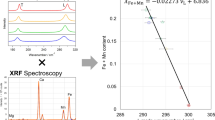Summary
One of the well-established techniques in rock analysis (main constituents, trace elements) is wavelength-dispersive X-ray spectrometry, WDS-XFA. Energy-dispersive X-ray spectrometry (EDS-XFA) is used as an attachment to scanning microscopes, electron microprobes, or for analyzing heavy elements/alloys, but seldom for analyzing silicate rocks, minerals, refractories or ceramics. A simultaneous and fast analysis of all main constituents or of several trace elements of a silicate specimen is feasible by EDS-XFA either working with diluted samples (fusion with Li2B4O7 e. g.), or with pressed powders. In the first case, no corrections for absorption or fluorescence effects may be necessary, but the pulse rates for the lightest detectable elements (Z = 11, 12) or trace elements (Z = 15 to 92) are too low, errors due to counting statistics unacceptably high. According to elemental configuration and concentration levels, a semi-quantitative to quantitative simultaneous analysis of all main constituents with Z ≥12 is possible under routine conditions. In the second case (pressed powder pellets) severe matrix and diffraction effects may occur such that the error of main component analysis is much higher than expected from counting statistics, even when a correction routine like the one after Rasberry-Heinrich is carried out. Trace elements with their higher limits of tolerated analytical error, however, can be analyzed simultaneously under routine conditions if appropriate primary filters and excitation conditions are chosen. For both, main component and trace analysis, a perfect sample preparation routine and high quality standard samples are strictly necessary.
Zusammenfassung
Geologische Proben sind in der Regel Vielkomponentensysteme und bestehen aus 6 bis 12 Haupt- und Nebenkomponenten meist niedriger Ordnungszahl. EDS-XF Analysen an Silicatstandards zeigen, daß unverdünnte Pulverpreßlinge zwar zählstatistisch brauchbare Signale liefern, daß Absorptions- und Fluorescenzkorrekturen notwendig sind, die aber im Falle der verwendeten Rasberry-Heinrich-Routine nicht zufriedenstellen. Schmelzaufschlüsse mit Li2B4O7 hoher Verdünnung (> 10∶1) ergeben über weite Konzentrationsbereiche lineare Eichfunktionen, hingegen ist die erreichbare Impulsausbeute bei den Elementen mit Z ≤12 gering und auch bei langen Meßzeiten von über 200 s und hohen Konzentrationen analytisch unbrauchbar. Unter Routinebedingungen ist eine semiquantitative bis quantitative Simultananalyse der Hauptkomponenten (Z ≥12) möglich, der Zeitaufwand für Präparation, Analyse und Auswertung liegt für 10 bis 12 Analysenelemente bei 15 bis 20 min.
Bei Verwendung von Pulverpreßlingen ist eine Spurenanalyse der Elemente mit Z ≥15 im Konzentrationsbereich von ≏20 bis 2000 ppm möglich, wenn geeignete Primärfilter und Anregungsbedingungen gewählt werden.
In jedem Fall —Hauptkomponentenoder Spurenanalyse — ist eine perfekte Präparationsroutine und eine genügend große Zahl guter Standardproben unerläßlich.
Similar content being viewed by others
Literatur
Abbey S (1980) Geol Surv Canada Pap 80-14
Abbey S (1983) Geol Surv Canada Pap 83-15
Bachmann H-H, Koberstein E, Straub R (1978) Chem-Techn 10:441
Govindaraju K (1982) Geost Newsl 6:91
Lindsay JR, Rose HJ, Larson RR (1982) Appl Spectr 36:520
Mazumoto K, Fuwa K (1979) Anal Chem 51:2355
Potts PJ, Webb PC, Watson JS (1984) X-Ray Spectrom 13:1
Rasberry SD, Heinrich FJ (1974) Anal Chem 46:81
Stern WB (1976) X-Ray Spectrom 5:56
Stern WB (1979) Schweiz Mineral Petrogr Mitt 59:83
Stern WB, Hänny HA (1982) J Gemmol 17:285
Vane RA, Stewart WD (1980) Advan X-Ray Anal 23
Author information
Authors and Affiliations
Rights and permissions
About this article
Cite this article
Stern, W.B. Zur Simultananalyse von Silicaten (Hauptkomponenten, Spuren) mittels energiedispersiver Röntgenfluorescenz-Spektrometrie (EDS-XFA). Z. Anal. Chem. 320, 6–14 (1985). https://doi.org/10.1007/BF00481071
Received:
Issue Date:
DOI: https://doi.org/10.1007/BF00481071




